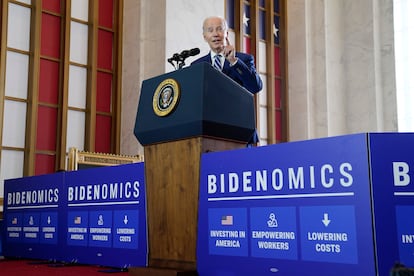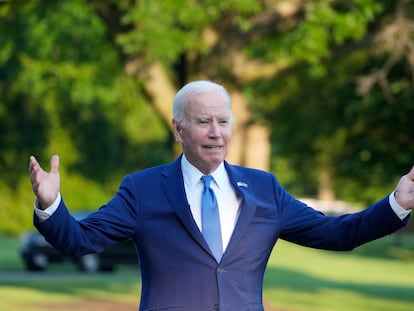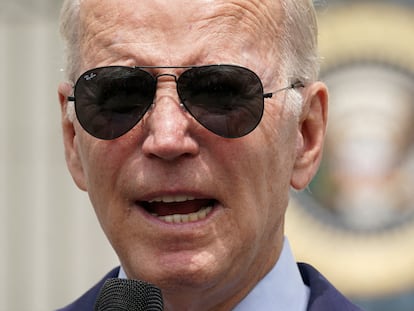‘Bidenomics’: The US president tries to sell his economic performance to skeptical voters
In a speech in Chicago, Joe Biden presented himself as a defender of workers and the middle class


On Wednesday morning, U.S. President Joe Biden landed in Chicago — which was covered in smoke from the Canadian wildfires — to give an economic policy speech. “[It’s] ‘Bidenomics.’ I don’t know what the hell that is… But it’s working,” the president said at a rally in Philadelphia on June 17, using the term for the first time, which he has since come to embrace. But inflation-stricken citizens — voters — don’t seem convinced. The economy is as hazy as the Chicago air; economists don’t know whether to expect a soft landing or a recession.
“Bidenomics is about building the economy from the center out and from the bottom up, not from the top down, by introducing three fundamental changes. First, making smart investments in the United States. Second, [educating] and [training] American workers to grow the middle class. And third, [promoting] competition to reduce costs and help small businesses,” Biden said in a speech that lasted just over half an hour.
Despite the spectacular scenery, Wednesday’s speech at the Old Post Office in Chicago was marred by lighting and sound problems. A somewhat dark, backlit Biden, whose voice sometimes sounded lost and at other times thundering, defended his economic achievements.
“Today, the U.S. has had the highest economic growth among the world’s leading economies since the pandemic. We’ve added over 13 million jobs, more jobs in two years than any President has added in a four-year term. And folks, that’s no accident. That’s Bidenomics in action,” he said.
The most successful and differential aspect of Biden’s policy consists of his promotion of infrastructure and investment aid in key sectors, like microprocessors and clean energy, using a somewhat protectionist approach for large projects. The infrastructure law and the Inflation Reduction Law have been his greatest legislative successes in economic matters. In addition, he averted the risk of a default with a successful debt ceiling agreement.
On the positive side, Biden can note the recovery of jobs destroyed by the pandemic, although that had more to do with the timing of the change at the White House than with his own policies. In any case, the president is presenting himself as a defender of workers and the middle class and describes himself as the most pro-union president in history.
On the negative side, his fiscal stimulus to get past the pandemic encouraged excess demand and contributed to soaring inflation when the Ukraine war and supply chain bottlenecks constrained supply. The role of the president and his administration is often less decisive in both price stability and the economy’s general performance than the Federal Reserve’s role. But citizens don’t vote for the head of the central bank; they vote for the president.
In the November 2022 congressional elections, the Democrats achieved a much better result than expected by using two arguments: the defense of democracy against extreme Trumpism and abortion, on the heels of the Supreme Court ruling that repealed it as a constitutional right throughout the country. At the time, the party’s major liability was skyrocketing inflation, much more so than now, which overshadowed other economic achievements.
Campaigning for 2024
Now that the pace of rising prices has slowed, Biden wants to use the economy as an argument in favor of his reelection in 2024. He already used it at an event in Washington on the same day he announced his campaign for reelection, and continued along those lines 10 days ago at a rally in Philadelphia.
Thus, Biden will be able to design a campaign around three axes: democratic values (a rich vein to tap, with Trump in the race); the right to abortion, which he defends but with which he does not feel very comfortable (“I’m a practicing Catholic. I’m not big on abortion, but guess what? Roe vs. Wade got it right,” he said on Tuesday at a closed-door event in Chevy Chase, Maryland); and the economy.
With the launch of his re-election campaign and an improving economy, Biden saw his approval rating rebound four percentage points in the past month to 43%, the highest point since August 2022, according to a poll released this week by Gallup. The recovery comes two months after receiving his presidency’s lowest approval rating. Even so, 54% of U.S. adults disapprove of his performance. The poll was conducted between June 1 and June 22, just after the debt ceiling deal was reached.
Citizens continue to take a dim view of Biden’s economic policy. A recently released Associated Press-NORC Center for Public Affairs Research poll reveals that only one in three U.S. adults (34%) approve of how he’s handled the economy. According to that poll, while 72% of Democratic voters approve of his overall performance, only 60% approve of how he’s handle the economy at a time when inflation has come down to less than half of what it was a year ago and unemployment is at fifty-year lows. Interestingly, Donald Trump had a 90% job approval rating among Republicans, even when unemployment rates were soaring.
It is striking that Biden’s low approval rating comes during the best economic period of his term in office and the threat of a recession before the 2024 presidential election still very much exists, as the Federal Reserve still has a couple of bullets left in the chamber in the form of rate hikes to prevent inflation. It’s the recession that never comes. “I’ve been hearing every month there’s going to be a recession next month,” Biden said Wednesday. “I don’t think we will [have one],” he added.
Sign up for our weekly newsletter to get more English-language news coverage from EL PAÍS USA Edition
Tu suscripción se está usando en otro dispositivo
¿Quieres añadir otro usuario a tu suscripción?
Si continúas leyendo en este dispositivo, no se podrá leer en el otro.
FlechaTu suscripción se está usando en otro dispositivo y solo puedes acceder a EL PAÍS desde un dispositivo a la vez.
Si quieres compartir tu cuenta, cambia tu suscripción a la modalidad Premium, así podrás añadir otro usuario. Cada uno accederá con su propia cuenta de email, lo que os permitirá personalizar vuestra experiencia en EL PAÍS.
¿Tienes una suscripción de empresa? Accede aquí para contratar más cuentas.
En el caso de no saber quién está usando tu cuenta, te recomendamos cambiar tu contraseña aquí.
Si decides continuar compartiendo tu cuenta, este mensaje se mostrará en tu dispositivo y en el de la otra persona que está usando tu cuenta de forma indefinida, afectando a tu experiencia de lectura. Puedes consultar aquí los términos y condiciones de la suscripción digital.
More information
Archived In
Últimas noticias
Most viewed
- Sinaloa Cartel war is taking its toll on Los Chapitos
- Oona Chaplin: ‘I told James Cameron that I was living in a treehouse and starting a permaculture project with a friend’
- Reinhard Genzel, Nobel laureate in physics: ‘One-minute videos will never give you the truth’
- Why the price of coffee has skyrocketed: from Brazilian plantations to specialty coffee houses
- Silver prices are going crazy: This is what’s fueling the rally










































